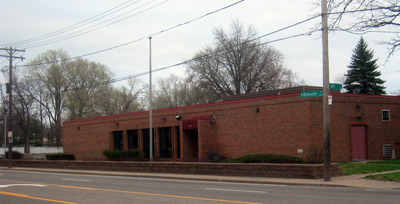Joyce Blumenshine is the chairwoman of the Heart of Illinois Group Sierra Club. She has long been a proponent of removing freight rail access on the Kellar Branch and converting the corridor to a hiking/biking trail. On February 6 of this year, she wrote a letter to the Journal Star again opposing train service on the branch, plus scoffing at the idea of a trolley being run on the line:
The rehash of the mystical trolley line is a bait and switch – another attempt to derail the trail for the benefit of Pioneer Railcorp at great cost to our community….
She signed her letter, “Joyce Blumenshine, Heart of Illinois Group Sierra Club.” So, she’s speaking for the Sierra Club.
The funny thing is, if you look at the Sierra Club’s website, you’ll find that Blumenshine is all alone in her criticism of trains and trolleys. The Sierra Club actually likes them. A lot. In fact, they have quite a bit of information on rail transportation, the quality of life and economic development it brings, and its positive effect on the environment.
In their 2004 Report on Sprawl (ironically titled, “Missing the Train”), the Sierra Club said, “Public transportation, particularly rail, spurs ‘transit-oriented development’ that helps create a vibrant environment where people can live, work, shop, and use public transportation with ease” (emphasis mine). Isn’t that interesting? And what’s the effect on the surrounding neighborhoods and businesses?
In the Washington, DC area, the public transportation system (Metro) has generated nearly $15 billion in surrounding private development. Between 1980 and 1990, 40 percent of the region’s retail and office space was built within walking distance of a Metro station.17 This has led to lively corridors with plentiful restaurants, shops, offices and residences in places like Alexandria, Clarendon and Arlington, Virginia; Bethesda and Silver Spring, Maryland; and the heart of Washington, DC.
The American Public Transportation Association (APTA) notes that demand for these transit-oriented neighborhoods far outpaces the supply, and cites studies showing that 30 percent of housing demand is for such communities while less than 2 percent of new housing is put in these areas. APTA states, “Real estate experts and demographers have … concluded the supply of TOD-style living environments, focused on high-quality public transportation, lags far behind demand.”18 APTA also calculates that the retail market benefits, because for every $10 million invested in public transit, they gauge that local business sales increase by $30 million.
“But that’s a full-fledged public transit, light-rail system,” you say. Granted. But consider a situation in Santa Cruz, California, that has some similarities to our situation here. There, like here, there is a scenic rail line that snakes through their county, and local Sierra Club members want to turn it into a hiking/biking trail. And there, like here, there is controversy surrounding it. Not the same controversy, but controversy.
The disagreement begins when discussing the best way for the county to purchase the corridor from Union Pacific. There are two options for buying the corridor. The first involves accepting $11 million of State Prop. 116 money…and matching it with transportation funds already allocated by the Santa Cruz County Regional Transportation Commission (RTC)….
In the first option, the State will provide the $11 million only if the county moves forward with some form of passenger rail service such as the proposed recreational Trolley [emphasis mine]. For many, this is a fair trade off. In fact, many people like trains and think the idea of moving around Santa Cruz by rail attractive.
There, the Sierra Club is in favor of the trolley with a trail alongside, within the corridor, but there are some residents who live along the train track that are against the trolley. The Ventana Chapter Sierra Club dryly muses, “It isn’t clear why people who don’t like trains purchased homes next to the railroad tracks.” Some are wondering the same thing here, especially about a certain Journal Star editor who lives near the train tracks but doesn’t want to see or hear trains on them.
The report concludes by saying, “The Sierra Club favors transportation that is energy and land conserving and is the least polluting. The Trolley project and the use of the rail corridor for bicycle travel has enormous potential to reduce automobile trips in Santa Cruz County.” Isn’t that exactly what the Illinois Prairie Railroad Foundation is trying to do in Peoria?
So the question that needs to be asked is, why is the Heart of Illinois Group Sierra Club against it? Why would the Heart of Illinois Sierra Club be anti-rail and, thus, pro-oil? Why would they rather take lumber off of environmentally-friendly and fuel-efficient train consists and instead put it on multiple oil-burning trucks that tear up our roadways and pollute our air? Why would they work against attempts to lessen automobile dependence? Why would they want to kill any hope of establishing a light rail system through the heart of the city?
The Sierra Club has published Conservation Policies that I would assume would apply to all chapters. Here’s what they say about trains/public transportation:
- “Rail systems are most effective in stimulating compact development patterns, increasing public transit patronage and reducing motor vehicle use.”
- “Station access should be provided by foot, bicycle and public transit, with minimal, but full-priced, public parking.”
- “Freight railroads, especially electrified, are preferred over highway or air freight to save energy and land, and cut noise and pollutant emissions.”
- “Land use patterns should be designed to improve pedestrian access, encourage shorter trips, increase public transit use, enhance the economic viability of public transit and decrease private motor vehicle use (auto mobility).”
Why is the Heart of Illinois Group Sierra Club opposing club policy in regards to the Kellar Branch? Are their leaders letting their personal feelings get in the way of their mission?



 The Journal Star is
The Journal Star is  I went to the library this evening to look up two Journal Star newspaper articles — one from 2005 and one from 2006. Just to prove I’m not a Luddite, I decided to try one of the library’s computer stations and utilize their free NewsBank service to just e-mail the articles I wanted from the library’s computer to my personal e-mail address. I’ve actually done it before and it was pretty slick.
I went to the library this evening to look up two Journal Star newspaper articles — one from 2005 and one from 2006. Just to prove I’m not a Luddite, I decided to try one of the library’s computer stations and utilize their free NewsBank service to just e-mail the articles I wanted from the library’s computer to my personal e-mail address. I’ve actually done it before and it was pretty slick.
